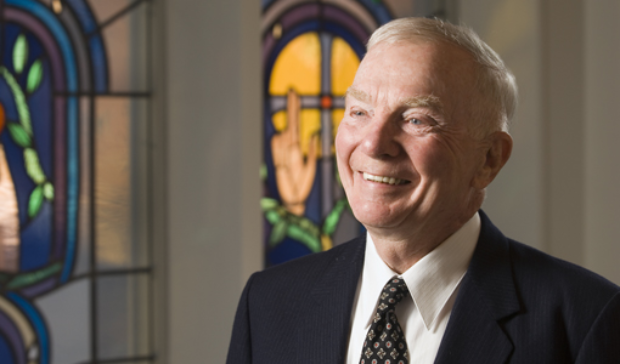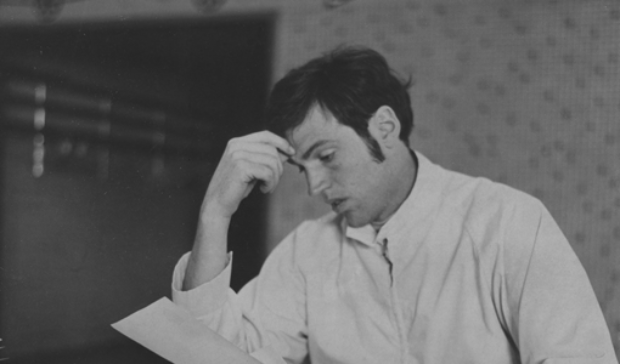Wander into the world of Thomas Kennelly '51 and you can't help but feel a little bit like you're watching a real-life version of the movie "Forrest Gump."
Because Kennelly, the 2007 University of St. Thomas Distinguished Alumnus, has lived a larger-than-life tale that would make any Hollywood screenwriter jealous. From going toe-to-toe with Jimmy Hoffa to putting former President Richard Nixon on the witness stand to helping create the federal Witness Protection Program, Kennelly can only summarize what reads like a ready-made movie script of a life in two words: "Heady days."
"I was blessed to have those wonderful adventures and work with those great people," said Kennelly, 77, a retired attorney and investigator who grew up in South St. Paul and lives in Napa, Calif., with his wife, Susan. "We made a little history, and I think you can't ask for more than that."
Kennelly was asked about his thoughts on being named Distinguished Alumnus.
"I was at home, and I got a message that the St. Thomas Alumni Office had called," he said, easing into the story as a train might slowly begin pulling away from the station. "I thought, 'Oh boy, here we go. It's another capital campaign. How much do they want this time?' But when I spoke to them and learned about the award, I was amazed and astounded. I figured they must have depleted their supply of CEOs, celebrities and major donors."
One thing Kennelly has never shied away from is a good story or a good laugh. In 2006, he published his memoir, One More Story And I'm Out The Door: A Life With Recollections About Jimmy Hoffa, the Mafia, G. Gordon Liddy, and Guardian Angels, Among Others. The book is a fascinating, lively and oftentimes humorous look into some of the most memorable characters and times of the 20th century's latter half - from Hoffa to Watergate, from RFK to Ronald Reagan. Kennelly's incredible journey is downright Gump-like in both his active participation in history-making moments and his "I just happened to be there when ..." scenes that made headlines around the globe.
Prologue: World War II and Catholic college
Kennelly's adventures started early. He was born in Dubuque, Iowa, where he lived with his parents and two siblings until 1940. With World War II raging, Kennelly's father, George, began taking jobs helping to build ammunition and defense plants all over the United States. The family lived in Tennessee, Alabama, California, Kentucky and Minnesota over the next two years. Kennelly and his family eventually settled in South St. Paul, where he went to high school and graduated in 1947.
"When it came to college, I really didn't want to go to St. Thomas," Kennelly recalled. "I wanted to go to the University of Minnesota, where all my high school buddies were going."
But Kennelly's mother, Olive, a devout Catholic, insisted that since he had not had a Catholic high school education, he would get one in college. St. Thomas was the choice.
"So off I went," he said, laughing at the memory of how he ended up at UST. "And I'm forever grateful to her for helping me land there. It had a profound impact on my life."
It was during his years at St. Thomas - from 1947 to 1951 - that Kennelly says he not only developed the research and debating skills that would one day aid him so greatly in courtrooms, but he also began to nurture and grow in what would become a driving force in his life - his Catholic faith.
"I really discovered the length and breadth of Catholic tradition," he said. "Including Catholic social acts, promoting the common good for all people."
Act I: Law School, Marines and the "Hoffa Squad"
After graduation, Kennelly attended law school at Santa Clara University, graduating in 1954. He served in the Marines from 1954 to 1958, working as a "JAG" lawyer and gaining what he calls "priceless" trial and courtroom experience.
Kennelly then took a job in France from 1958-60, working as a civilian lawyer employed by the Air Force. He later became an Assistant U. S. Attorney in San Francisco. That eventually led to the chance in 1962 to move to Washington and become part of the "Hoffa Squad," a new outfit put together by Attorney General Robert F. Kennedy to investigate ties between Teamsters and the Mafia.
Teamsters kingpin Jimmy Hoffa was at the front of it all, and Kennelly was among those who worked closely with Kennedy to eventually bring Hoffa down.
"Robert Kennedy was intensely interested in the cause of justice," Kennelly said. "He generated strong loyalty among everyone who knew him and worked for him. At the same time he was somewhat shy, but always able to put us at ease with his ready smile and Irish wit. You felt as though you were part of a great and wonderful cause when you worked for Robert Kennedy."
By the time the "Hoffa Squad" disbanded a few years later, Kennelly had helped ring up more than 115 convictions, including Hoffa, who would spend eight years in prison. Kennelly only met Hoffa face-to-face once, in the spring of 1964, but it was an encounter he'll never forget.
Armed with a subpoena for a large number of Teamsters documents relating to a case in Puerto Rico he was working on, Kennelly burst into the union's Washington, D.C., headquarters, which Hoffa ruled over like a dictator.
"I gave no advance notice, fearing that some of the documents might be destroyed," Kennelly wrote in his memoir. "I presented myself to the house counsel and the two of us proceeded to the basement where, at my request, we commandeered all the photocopying machines. After about an hour, down came Hoffa himself, demanding to know why the (heck) nobody could get anything copied. His attorney tried to explain the situation, but he turned on me with fury in his eyes and snarled, 'You dumb bunch of government (expletive), you never had to meet a payroll - you never could run a business.' I couldn't resist replying, 'Well, Hoffa, we were smart enough to convict you.' "
Hoffa then flew into a rage and was ready to begin talking with his fists before his attorney led him away, Kennelly recalls.
In the summer of 1964, Kennelly was part of a group dispatched by RFK to deal with the escalating tensions in Mississippi after the murder of three young civil rights workers - a situation famously portrayed in the 1988 film "Mississippi Burning." He spent much of his time talking with local law enforcement officials, many of whom were proud members of the White Knights of the Ku Klux Klan.
Act II: The Witness Protection Program
In the summer of 1967, Kennelly was working in Buffalo, N.Y., as part of a new government strike force designed to put members of the mafia behind bars. During one particular investigation, Kennelly caught a break - a Buffalo police officer knew of an unhappy mafia member - Paddy Calabrese - sitting in jail who was willing to testify against his cohorts.
Because of "Omerta," the mafia's famous "code of silence," it was understood that any mob member who talked would instantly have a contract out on him and his family's lives.
"So the major problem was how to keep Calabrese, his wife and three children alive," Kennelly said.
Kennelly and his fellow agents called in favors and checked with contacts. A former CIA agent was able to get new birth certificates with fake names for the whole family. Someone else obtained phony Social Security cards. A sympathetic priest even donated fake baptismal certificates. Someone else had a friend who was a school superintendent in a different state, and he agreed to provide false records for the two children who were of school age. On and on it went, right down to Kennelly and his men chipping in and buying the Calabrese family a used Chevy for $800 to drive to their new life in the deep South.
"That was about it," Kennelly wrote in his memoir regarding the birth of the Witness Protection Program. "It was haphazard and seat-of-the-pants, but it was the beginning ... and it was effective. It was an antidote to the code of silence."
The federal Witness Protection Program later became institutionalized by congressional legislation, but by then Kennelly's adventure moved on to other locales.
Act III: Watergate, Deep Throat and Nixon
In 1972, Kennelly - now in private practice - found himself in the middle of what would become one of the greatest scandals in American history. G. Gordon Liddy, the former White House staffer who had masterminded the bungled break-in at the Watergate Hotel, setting off a chain of events that ultimately led to President Nixon's resignation in 1974, needed local counsel at his trial. Bill Bittman, an old friend of Kennelly's from the "Hoffa Squad" days, was representing one of the other key Watergate figures, E. Howard Hunt, and recommended Liddy use Kennelly.
So on Jan. 8, 1973, when the trial began, Time magazine ran a photo of Watergate mastermind G. Gordon Liddy and his lawyer, Thomas Kennelly, as they entered the courtroom. In the coming weeks, Kennelly was at the center of a media feeding frenzy, with reporters - including young up-and-comers such as Sam Donaldson, Connie Chung and Leslie Stahl - calling him at all hours, trying to get anything they could on Liddy's situation.
"It was fun," Kennelly says. "But it's no claim to fame - the jury was out only 45 minutes. It was a pretty hopeless situation from the beginning."
Toward the end of the 1970s, Kennelly found himself representing Ed Miller, a former FBI official charged with authorizing illegal "Black Bag" operations as part of the search for "Weatherman Underground" fugitives. Weatherman Underground members were anti-war extremists who took to bombing federal and commercial buildings as a way to protest the Vietnam War.
In the midst of defending Miller, Kennelly was introduced to another former FBI official, Mark Felt, who was also on trial for the same illegal black bag operations.
Former President Nixon was ultimately pursued as a witness because he had been the commander-in-chief at the time the alleged illegal operations took place. Kennelly spent an hour privately interviewing Nixon and left with a personalized copy of the president's newly released memoir.
In 1980, history was made yet again when Nixon took the stand inside a Washington, D.C., courtroom during the trial involving Miller and Felt. It was the first time a former president had testified in any courtroom, and it also marked the first time Nixon had returned to the nation's capital since his resignation. The lawyer who spent the next 45 minutes questioning him in front of a rapt audience? Tom Kennelly.
Felt and Miller were convicted, and Nixon sent both, along with Kennelly, a personal note of condolence and a bottle of champagne. Nixon had no idea, of course, that the very same Felt he was offering his sympathies to was in fact "Deep Throat," the anonymous source who fed Washington Post reporters Bob Woodward and Carl Bernstein much of the information that led to Nixon's downfall.
"Heady days," Kennelly says, flashing his trademark Irish smile.
Epilogue: Retirement and Romping with Grandchildren
These days Kennelly's biggest adventures involve getting down on the floor and playing with his 1- and 3-year-old grandsons.
"I can just get down and romp around with them, make a fool of myself and not have any qualms," he said. "Life is good."
No. If you're Thomas Kennelly, life is not merely good. If you're Thomas Kennelly, life is nothing short of a great adventure.
Find novelist and freelance writer John Nemo online at www.JohnNemoBooks.com.







